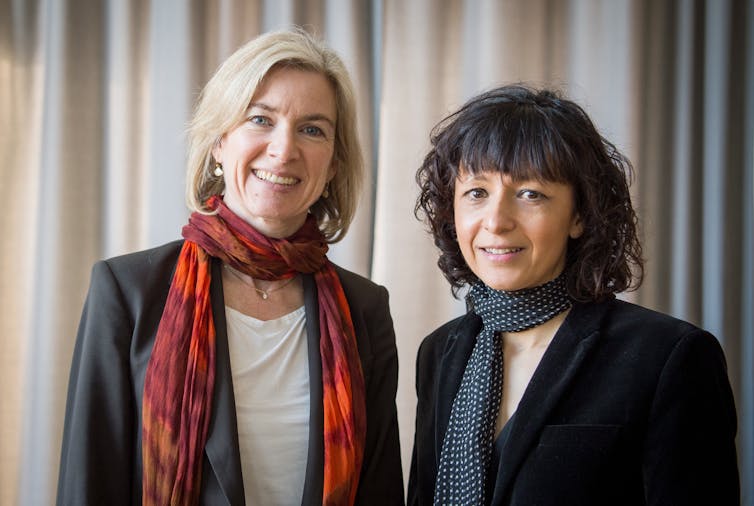The Royal Swedish Academy of Sciences yesterday awarded the 2020 Nobel Prize in Chemistry to Emmanuelle Charpentier and Jennifer Doudna for their do the job on CRISPR, a system of genome editing.
A genome is the comprehensive set of genetic “instructions” that figure out how an organism will develop. Employing CRISPR, researchers can slash up DNA in an organism’s genome and edit its sequence.
CRISPR technological know-how is a powerhouse for fundamental study and is also switching the globe we live in. There are 1000’s of research papers posted each and every 12 months on its various applications.
These consist of accelerating investigation into cancers, psychological ailment, probable animal to human organ transplants, improved food items generation, eliminating malaria-carrying mosquitoes and preserving animals from disease.
Charpentier is the director at the Max Planck Institute for Infection Biology in Berlin, Germany and Doudna is a professor at the College of California, Berkeley. Both played a vital position in demonstrating how CRISPR could be used to focus on DNA sequences of curiosity.
Examine far more:
Why a lot more females will not get science Nobels
Having benefit of bacterial immunity
CRISPR technological innovation is adapted from a process that is the natural way existing in micro organism and other unicellular organisms regarded as archaea.
This organic system presents microbes a sort of acquired immunity. It protects them from overseas genetic factors (such as invading viruses) and allows them “remember” these in circumstance they reappear.
Like most advancements in modern-day science, the discovery of CRISPR and its emergence as a essential genome editing strategy concerned initiatives by quite a few researchers, in excess of various many years.
In 1987, Japanese molecular biologist Yoshizumi Ishino and his colleagues ended up the initially to observe, in E. coli micro organism, uncommon clusters of repeated DNA sequences interrupted by shorter sequences.
Spanish molecular biologist Francisco Mojica and colleagues afterwards confirmed related buildings were existing in other organisms and proposed to get in touch with them CRISPR: Clustered On a regular basis Interspaced Short Palindromic Repeats.
In 2005, Mojica and other teams described the quick sequences (or “spacers”) interrupting the repeats have been derived from other DNA belonging to viruses.
Evolutionary biologists Kira Makarova, Eugene Koonin and colleagues eventually proposed CRISPR and the affiliated Cas9 genes were performing as the immune system. This was experimentally verified in 2007 by Rodolphe Barrangou and colleagues.
A programmable method
The CRISPR-associated genes, Cas9, encode a protein that “cuts” DNA. This is the energetic component of the defence versus viruses, as it destroys the invading DNA.
In 2012, Charpentier and Doudna showed the spacers acted as markers that guided where by Cas9 would make a minimize in the DNA. They also showed an synthetic Cas9 procedure could be programmed to target any DNA sequence in a lab location.
This was a groundbreaking discovery which opened the door for CRISPR’s wider apps in investigate.
In 2013, for the initially time, teams led by American biochemist Feng Zhang and geneticist George Church claimed genome modifying in human mobile cultures employing CRISPR-Cas9. It has since been utilized in innumerable organisms from yeast to cows, crops and corals.
Now, CRISPR is the most well-liked gene-modifying instrument for hundreds of researchers.

J.L. Cereijido/EPA
A technological revolution with unlimited purposes
People have altered the genomes of species for 1000’s of many years. At first, this was via strategies this sort of as selective breeding.
Nonetheless, genetic engineering – the immediate manipulation of DNA by human beings exterior of breeding and mutations – has only existed given that the 1970s.
CRISPR-primarily based methods fundamentally adjusted this area, as they let for genomes to be edited in dwelling organisms cheaply, with simplicity and with extraordinary precision.
CRISPR is at present making a enormous effects in health. There are scientific trials on its use for blood ailments this sort of as sickle mobile disease or beta-thalassemia, for the cure of the most frequent lead to of inherited childhood blindness (Leber congenital amaurosis) and for most cancers immunotherapy.
CRISPR also has excellent prospective in food output. It can be used to make improvements to crop top quality, yield, disease resistance and herbicide resistance.
Applied on livestock, it can lead to better disorder resistance, greater animal welfare and enhanced productive qualities – that is, animals generating a lot more meat, milk or significant-top quality wool.
With good power…
A range of problems to the technology stay, nonetheless. Some are technological, this kind of as the threat of off-target modifications (which happen when Cas9 cuts at unintended places in the genome).
Other troubles are societal. CRISPR was famously used in a person of the most controversial experiments of new a long time.
Study more:
Why we need to have a global citizens’ assembly on gene enhancing
Chinese biophysicist He Jiankui unsuccessfully attempted to use the technological innovation to modify human embryos and make them resistant to HIV (human immunodeficiency virus). This led to the beginning of twins Lulu and Nana.
We want a broad and inclusive dialogue on the regulation of these technologies – particularly specified their broad purposes and possible.
To quote CRISPR researcher Fyodor Urnov, Charpentier and Doudna’s operate seriously has “changed everything”.









More Stories
How to set up Hotspot on iPad?
Top 5 Best Power Bank Portable Chargers in 2018 Reviews
Rad Power Bikes CEO Mike Radenbaugh replaced by former Sony leader Phil Molyneux – GeekWire